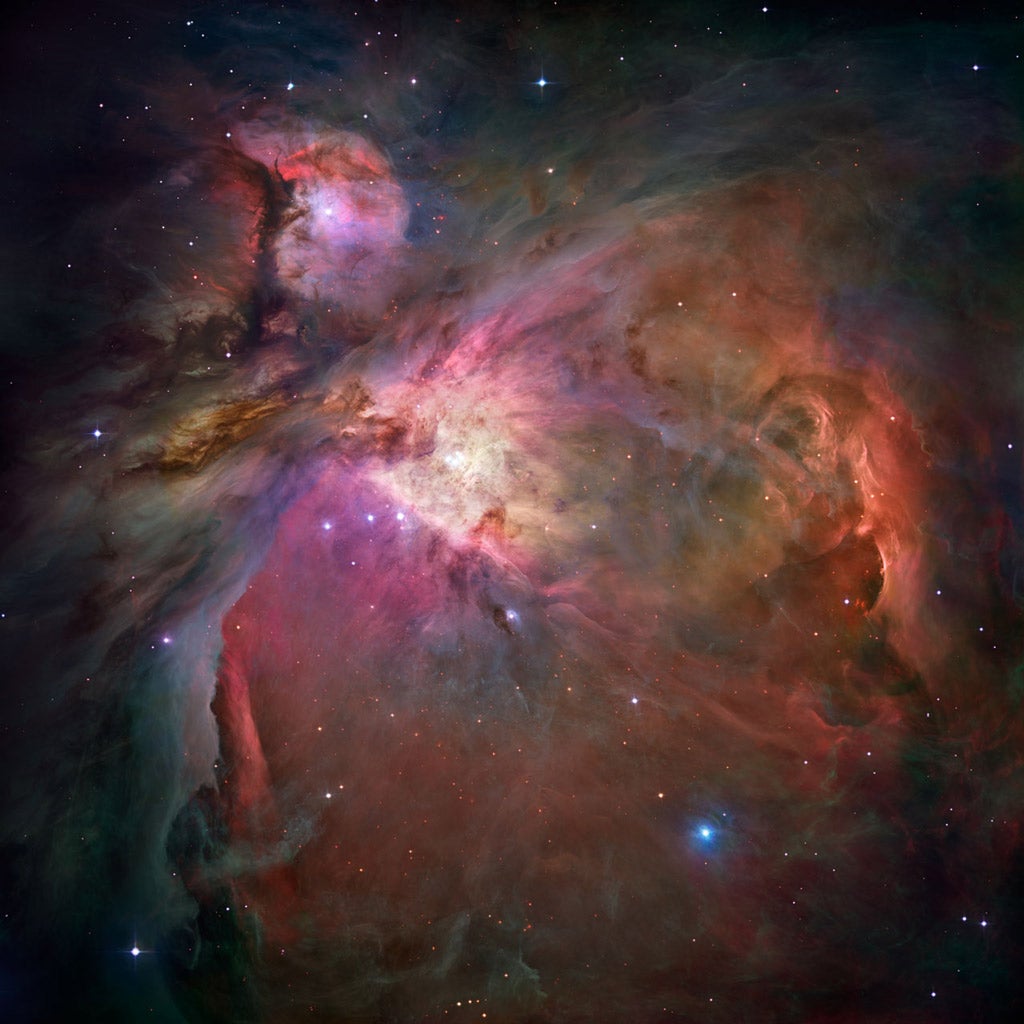The Orion Nebula (M42) is one of the most easily recognizable and best-studied celestial objects. It is a huge complex of gas and dust where massive stars are forming and is the closest such region to Earth. The glowing gas is so bright that it is visible with the unaided eye and is a fascinating sight through a telescope. Despite its familiarity and closeness, there is still much to learn about this stellar nursery. It was only in 2007, for instance, that the nebula was shown to be closer to us than previously thought — 1,350 light-years rather than about 1,500 light-years.
Astronomers have used the Wide Field Imager on the MPG/ESO 2.2-meter telescope at ESO to observe the stars within M42. They found that the faint red dwarfs in the star cluster associated with the glowing gas radiate more light than had previously been thought, giving us further insights into this famous object and the stars that it hosts. The data collected for this science project, with no original intention to make a color image, have now been reused to create the richly detailed picture of M42 shown here.
The image is a composite of several exposures taken through a total of five different filters. Light that passed through a red filter as well as light from a filter that shows the glowing hydrogen gas were colored red. Light in the yellow-green part of the spectrum is colored green, blue light is colored blue, and light that passed through an ultraviolet filter has been colored purple. The exposure times were about 52 minutes through each filter.
Chekalin was awarded the first prize of the competition for his composition of M78, and he also submitted an image of NGC3169, NGC3166, and SN 2003cg, which was ranked second-highest.
ESO’s Hidden Treasures 2010 competition gave amateur astronomers the opportunity to search through ESO’s vast archives of astronomical data, hoping for a well-hidden gem that needed polishing by the entrants. Participants submitted nearly 100 entries, and 10 skilled people were awarded some extremely attractive prizes, including an all-expense-paid trip for the overall winner to ESO’s Very Large Telescope on Cerro Paranal, in Chile, the world’s most advanced optical telescope. The 10 winners submitted a total of 20 images that were ranked as the highest entries in the competition out of the near 100 images.
The Orion Nebula (M42) is one of the most easily recognizable and best-studied celestial objects. It is a huge complex of gas and dust where massive stars are forming and is the closest such region to Earth. The glowing gas is so bright that it is visible with the unaided eye and is a fascinating sight through a telescope. Despite its familiarity and closeness, there is still much to learn about this stellar nursery. It was only in 2007, for instance, that the nebula was shown to be closer to us than previously thought — 1,350 light-years rather than about 1,500 light-years.
Astronomers have used the Wide Field Imager on the MPG/ESO 2.2-meter telescope at ESO to observe the stars within M42. They found that the faint red dwarfs in the star cluster associated with the glowing gas radiate more light than had previously been thought, giving us further insights into this famous object and the stars that it hosts. The data collected for this science project, with no original intention to make a color image, have now been reused to create the richly detailed picture of M42 shown here.
The image is a composite of several exposures taken through a total of five different filters. Light that passed through a red filter as well as light from a filter that shows the glowing hydrogen gas were colored red. Light in the yellow-green part of the spectrum is colored green, blue light is colored blue, and light that passed through an ultraviolet filter has been colored purple. The exposure times were about 52 minutes through each filter.
Chekalin was awarded the first prize of the competition for his composition of M78, and he also submitted an image of NGC3169, NGC3166, and SN 2003cg, which was ranked second-highest.
ESO’s Hidden Treasures 2010 competition gave amateur astronomers the opportunity to search through ESO’s vast archives of astronomical data, hoping for a well-hidden gem that needed polishing by the entrants. Participants submitted nearly 100 entries, and 10 skilled people were awarded some extremely attractive prizes, including an all-expense-paid trip for the overall winner to ESO’s Very Large Telescope on Cerro Paranal, in Chile, the world’s most advanced optical telescope. The 10 winners submitted a total of 20 images that were ranked as the highest entries in the competition out of the near 100 images.










